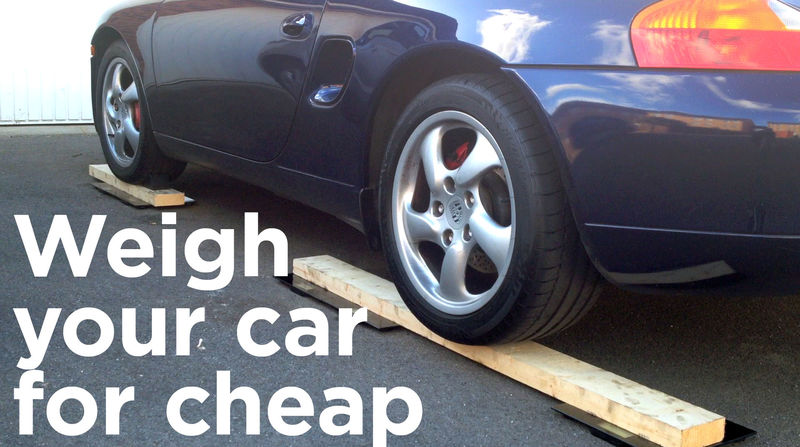A bit of fun this one. Professional corner weights are about £800 so can you spend 1/10th of that and use bathroom scales? Here's my video.
https://youtu.be/071xPmVgE0E

If you are like me and obsess about car stats such as power to weight ratios or if you’ve removed or replaced parts on your car then you’ll want to know how much your car actually weighs. The cheapest corner weigh system I could find was just under £800. Bathroom scales are about £10 each so I wondered if I could use theses instead?
My car’s handbook says the car weighs on average 1375 kg. Bathroom scales can weigh up to 180 kg each so 1375 divided by 180 is roughly 8. Surely putting two under each wheel would give close to the correct weight? I went to my local supermarket and bought 10 scales to find out.
Here’s a summary of what we’ll be doing
• Lift one wheel
• Place scales
• Place wood
• Lower wheel
• Repeat
• Tools and parts you will need
• Jack
• Wheel Chocks
• Ten Bathroom Scales rated to 180 Kilos
• Wood at least 50mm thick.
1. Take a note of how much fuel is in the car. Here you can see I’ve about a quarter tank. You’ll need this to work out the final weight of the car.
2. Remove anything you are not going to keep in the car. Here I’ve removed the spare wheel toolkit and cd player.
3. I picked up two 2.4 metre “2x5”s from a local hardware store. These measure 47mil x 125mil. I made one cut at 900 mil on each piece of wood to give me four pieces: two of 900 mil and two of 1500 mil.
4. Next you’ll need to lift one corner of your car. Please click the screen now refer to my lifting guide if you’ve not sure about this.
5. Make sure the handbrake is on and lift the passenger side front wheel first.
6. Place two scales under the wheel then place a piece of wood on top.
7. Slowly lower the wheel onto the wood.
8. Place a chock in front of the wheel to stop the car rolling forward when you lift the rear.
9. Repeat for the remaining wheels.
10. If your car is light enough in theory that should be it. In reality the rear of my Boxster is much heavier than the front (due to the engine being there) and would error the scales.
11. To fix this I used 3 scales each on the rear wheels. You have to experiment with the scale’s position as you need to spread the load evenly over them.
12. Once you have all 4 wheels on scales and each scale giving you a reading remove the chocks and simply write down the reading on each. You will have to give each scale a nudge to get them to display the reading.
13. So here are the results for my Boxster.
The front driver’s corner is 143.1+153.4=296.5
The front passenger is 139.5+130.7=270.2
The rear driver is 179.3+62.8+130.7=372.8
The rear passenger is 32.4+182.4+171.5=386.3
14. This gives a subtotal of 1385.8 kg
The wood weighed 11.8 kg so removing that we have 1374kg
15. Let’s talk about the weight of the fuel. From my research petrol weighs 0.74 kilos a litre. My car has a 64 litre tank so a quarter of that is 16 so the fuel in the car weighs roughly 8 kilos.
So without fuel my car weighs 1374-8= 1366 kg
16. So at 1366 kg that almost in the middle of the weight range for this car given by the handbook so whilst the bathroom scales may not be absolutely accurate they are in the ballpark. I’ll try to get the car on professional scales and see how accurate this in in the future.
17. For those who are curious, the weight of the spare tyre is 12.1 kg, the tool kit and warning triangle is about 3.2 kg (730+884+1640 = 3254g) and the cd player weighs just under 1.9 kg (1.894g) making a total of 17 kg
18. Final power to weight stats for all those interested.
Boxster S: 252 bhp
Car empty: 184 bhp/t
(252/1.366)
Car with half tank fuel and me: 172 bhp/t
252/(1366+24+75)
As above but without 17kg removed: 170bhp/t
252/(1366+24+75+17)
You’ll notice that removing the 17 kilos of weight from the car is the equivalent of an extra 2 bhp per tonne.